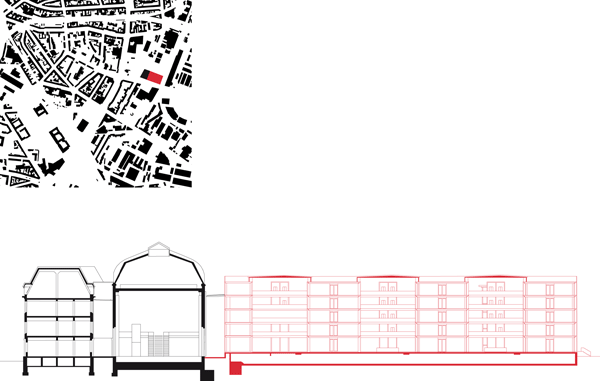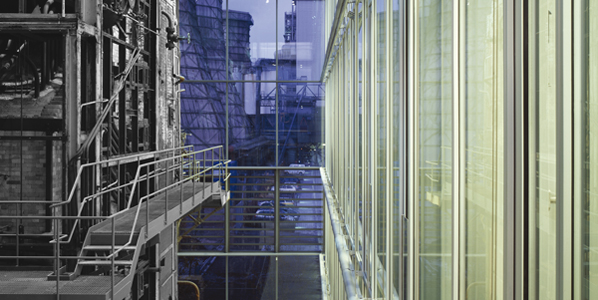
Working with Dinosaurs – Die Einverleibung des Industriezeitalters
Die Düsseldorfer Stadtwerke verlegten ihre Hauptverwaltung auf das Gelände eines ehemaligen Kraftwerks. Der neu errichtete Bürokomplex umfasst vier große Baukörper, die parallel zu den zwei historischen Industriegebäuden angeordnet und über Höfe verbunden sind. Die Altbauten sind über gläserne Korridore an die Neubaustruktur angeschlossen. Untereinander sind die neuen Baukörper jeweils durch Fußgängerbrücken verbunden.
Die Turbinenhalle von Erasmus Kittler aus dem Jahr 1889 und das ehemalige Verwaltungsgebäude verfügen nach dem Umbau über ein Kundenzentrum im Erd- und einen Veranstaltungssaal im Obergeschoss; der Charakter einer Maschinenhalle ist noch immer spürbar. Der Haupteingang zum Bürokomplex befindet sich an einem der verglasten Korridore, welcher von der Anfahrtsstraße und dem angrenzenden Park aus zugänglich ist.
Je ein ausgedienter Kohle-Paternoster, ein Transportschacht, eine Turbine und ein Kessel sind in räumlicher Nähe zu den Büroarbeitsplätzen ausgestellt – wie Dinosaurier in einem Naturkundemuseum. Sie führen so die industrielle Geschichte des Standorts deutlich vor Augen.
Working with Dinosaurs – Annexing the industrial age
Düsseldorf's public utilities company decided to establish its new headquarters on a vast derelict power plant site dominated by late 19th century industrial architecture. Ingenhoven architects were asked to design an office building that would gather the previously scattered company departments under one roof. They chose a concept composed of slabs positioned parallel to the two main historic buildings and linked by courtyards. Glazed corridors connect the preserved buildings and link them to the new structure.
The turbine hall and the former administration building were originally built by Erasmus Kittler in 1889, the converted hall now has a client centre on the ground floor and an auditorium on the first floor, yet the character of the great machine hall is still very much present. The main entrance to the complex is located in a glazed passageway accessible from the street and the neighbouring park. The four new slabs are connected by footbridges, which cross the atria between the buildings. All levels are connected with open vertical circulation.
A sectioned coal-bearing paternoster lift, the chute, one of the original turbines and a cut-away boiler have also been preserved in the complex – like dinosaurs in a natural history museum – both documenting and highlighting of the building's history.



